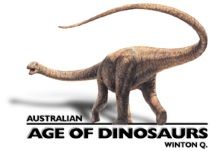Rapator ornitholestoides
 Pronunciation
Pronunciation
Rap-ah-tore Orr-nith-o-less-toy-dees
Meaning
Plunderer resembling Ornitholestes (a theropod from USA, which means ‘bird thief’)
Period
Early Cretaceous (113–100 Mya)
Discovery and publication
Found at Lightning Ridge, New South Wales, sometime before 1909 by opal dealer Tullie Cornthwaite Wollaston. It was named by German palaeontologist Friedrich von Huene in 1932 (along with Fulgurotherium and Walgettosuchus). The specimen is held at the Natural History Museum, London, United Kingdom.
Description
The original specimen of the theropod Rapator is an opalised left first metacarpal (one of the bones from the palm of the hand). When it was first described by Friedrich von Huene, he thought it was from a theropod similar to, albeit larger than, Ornitholestes — a Jurassic theropod from the USA. However, comparison of Rapator with other Australian theropods was not possible until recently because none preserved metacarpals. That changed with the discovery of Australovenator wintonensis, and in 2013 Dr Matt White studied the metacarpals of Australovenator and Rapator. It was shown that they were clearly different in structure; furthermore, the two theropods were separated from one another in time by more than five million years. However, while Rapator is regarded as distinct from Australovenator, it is likely that it too is a megaraptoran theropod, and therefore a close relative.
Rapator was a theropod probably similar in shape too, but slightly smaller than, Australovenator, at about 4–5m long.
